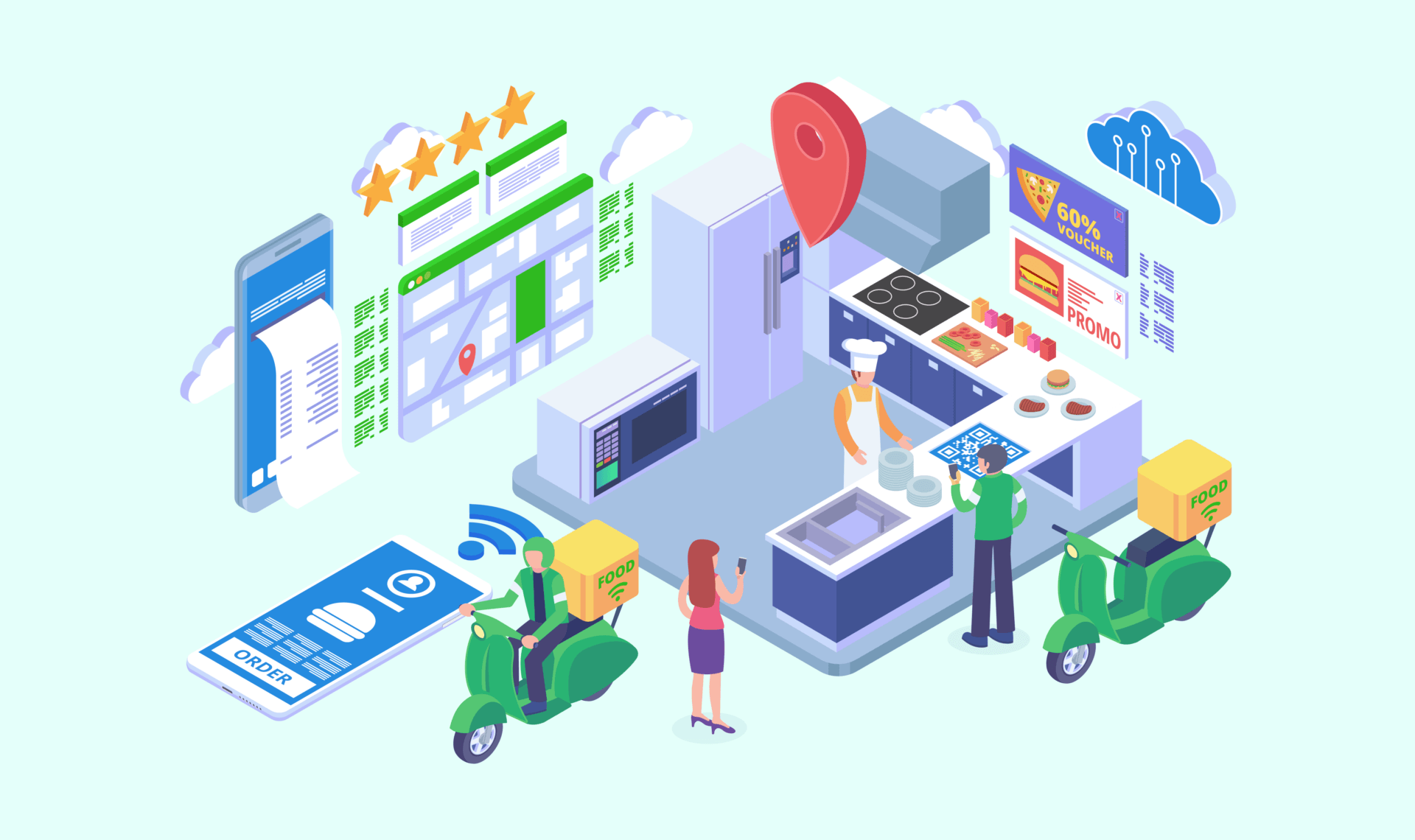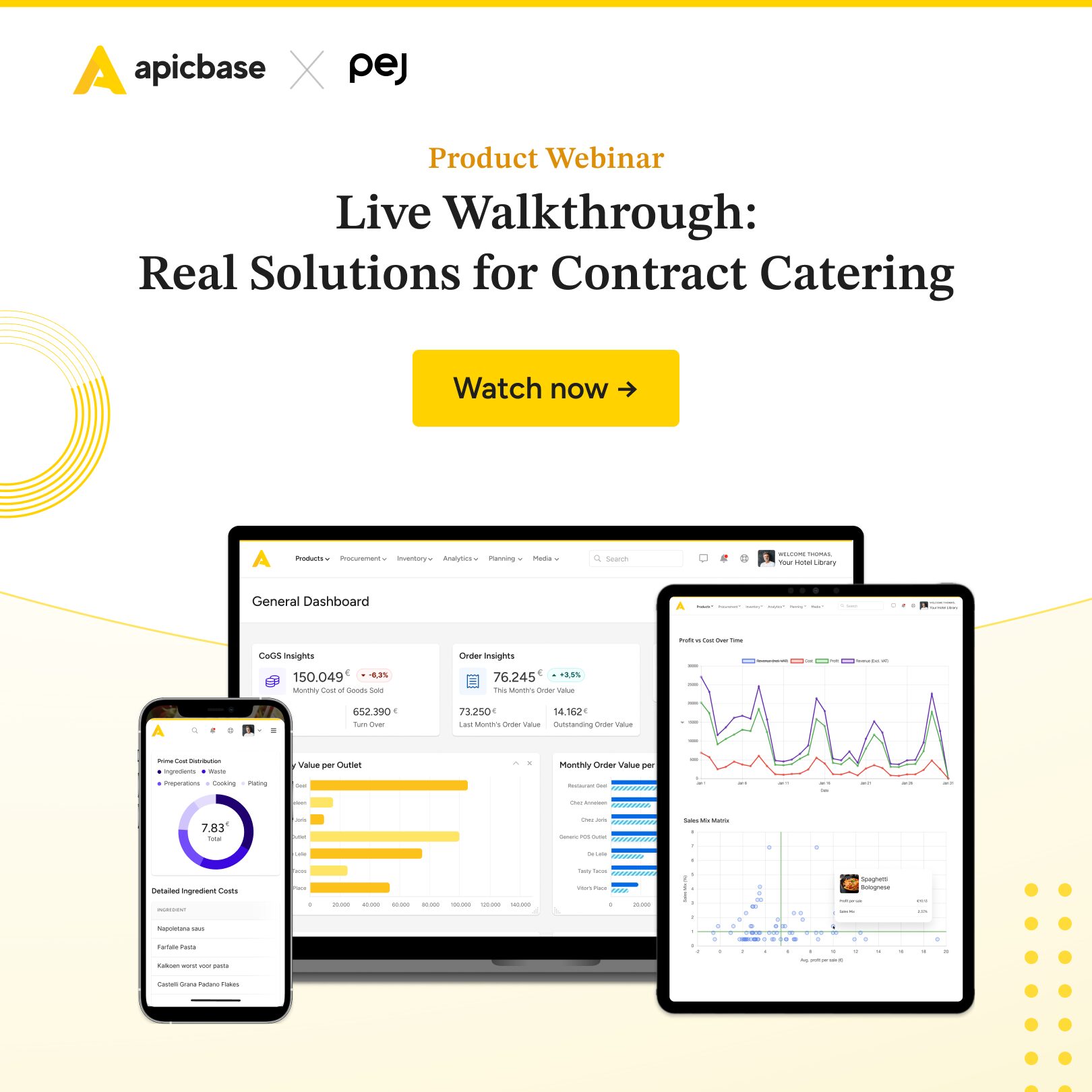Sie betreiben eine Cloud-Küche (oder denken darüber nach, sie zu betreiben), und Sie versuchen herauszufinden, wie Sie Ihre Kosten niedrig halten können?
(Oder eine Geisterküche. Ähm, virtuelle Küche? Oder vielleicht eine dunkle Küche? Für diesen Beitrag sollten wir uns darauf einigen, dass wir diese Begriffe austauschbar verwenden können, sonst kommen wir nicht weiter).
Wie dem auch sei, Hut ab, dass Sie die (Verringerung der) Kosten in den Mittelpunkt stellen.
Lassen Sie uns also kurz auf zwei grundlegende Attraktionen dieses (relativ) neuen Konzepts der Lebensmittelindustrie eingehen:
- Cloud-Küchen können sehr profitabel sein (achten Sie auf das „kann“ dort), und;
- Cloud-Küchen sind viel einfacher zu skalieren als Dine-in-Betriebe.
Aber der Weg zur Rentabilität ist mit Dornen und Dornensträuchern übersät. Die meisten Betreiber von Cloud-Küchen arbeiten mit geringen Gewinnspannen. Und die Skalierung eines Unternehmens mit geringen Gewinnspannen ist beängstigend.
Die einzige Möglichkeit, mit Cloud-Küchen wirklich Geld zu verdienen, besteht darin, die Kostenseite der Dinge immer im Auge zu behalten.
Deshalb möchte ich in diesem Beitrag 24 Möglichkeiten aufzeigen, wie Betreiber von Cloud-Küchen ihre Kosten senken können, ohne Kompromisse bei der Lebensmittelqualität oder der Zufriedenheit ihrer Mitarbeiter einzugehen.
- Allgemeine Tipps zur Kostensenkung in der Cloud-Küche
- Hacks für das Lebensmittelkostenmanagement
- Ideen zur Senkung der Miet- und Immobilienkosten
- Bewährte Praktiken der Abfallwirtschaft
- Tipps und Tricks zu den Arbeitskosten
- Lieferkosten-Hacks
Schauen wir genauer hin.
Allgemeine Tipps zur Kostensenkung in der Cloud-Küche
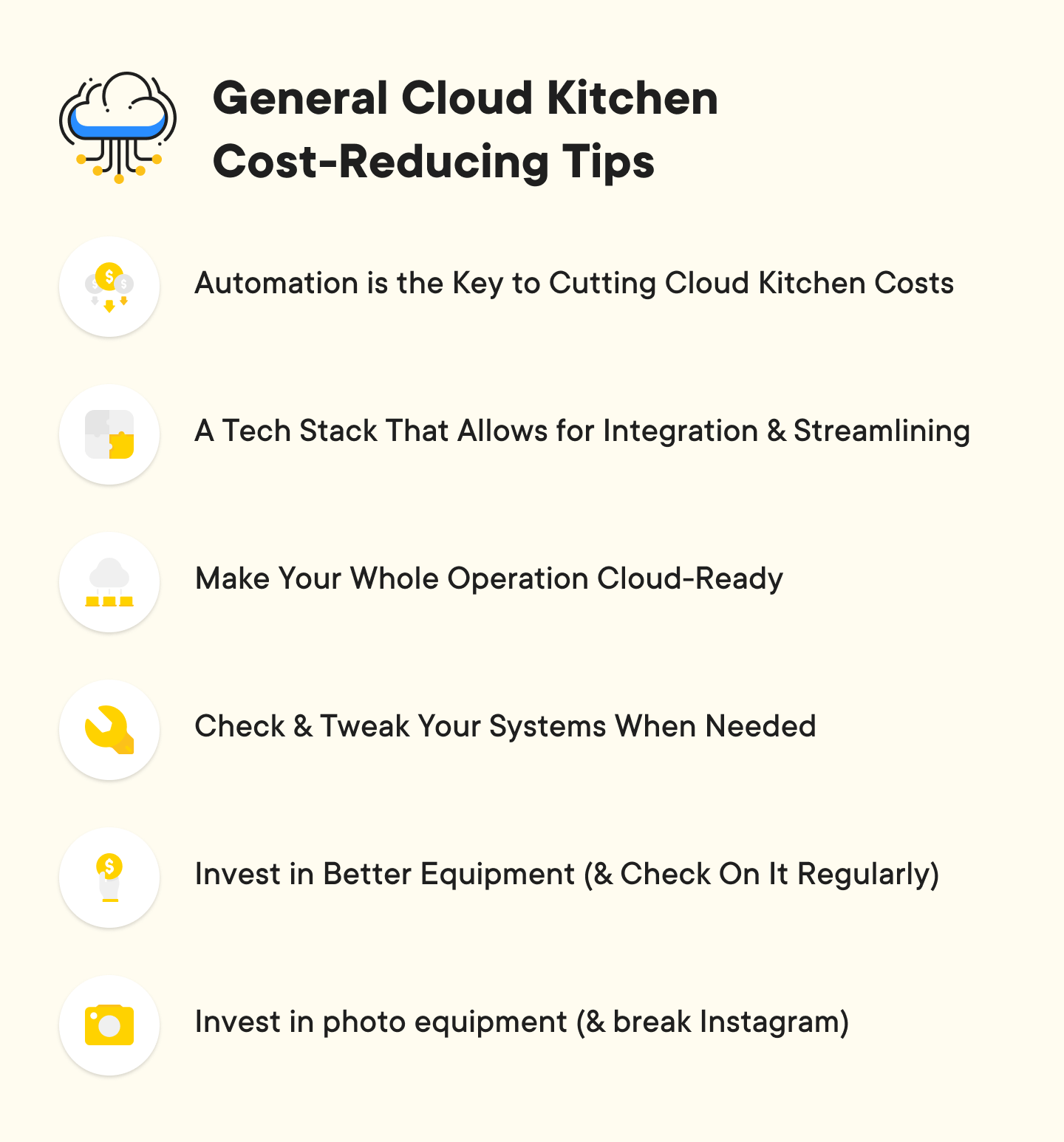
1. Automatisierung ist der Schlüssel zur Senkung der Kosten für Cloud-Küchen
Um die Kosten zu senken, sollten Sie versuchen, so viele BoH-Prozesse wie möglich zu automatisieren.
Die offensichtlich automatisierungsreifen Prozesse, die einem in den Sinn kommen, sind Einkauf, Rechnungsstellung, Bestandszählungen und Lebensmittelkostenberechnungen. Das sind alles softwaretaugliche Dinge, die Apps besser als Menschen erledigen können.
Wenn Sie nach den Sternen greifen wollen, ist die Installation eines Fließbandes, das die vorbereiteten Speisen zu einem Mitnahmefenster bringt (wie es in Sushi-Restaurants mit Selbstbedienung bereits praktiziert wird), eine großartige Möglichkeit, die Kosten für Vollzeitkräfte und Arbeitskräfte zu senken.
Und wussten Sie, dass es bereits Roboterköche gibt? Apicbase hat sich kürzlich mit ICE + FRIES in Reykjavik zusammengetan, um ihnen dabei zu helfen, die weltweit fortschrittlichste bionische Streetfood-Bar zu schaffen, in der Roboter Cocktails mixen und Pommes zubereiten.
Der gesamte F&B-Prozess, von der Bestellung über die Produktion und Beschaffung bis hin zur Bestandsaufnahme, ist ein geschlossener Kreislauf, der vollständig von Apicbase gesteuert wird. Darüber sollte man nachdenken, oder?
2. Ein technischer Stack, der Integration und Rationalisierung ermöglicht
Entscheiden Sie sich für eine technische Lösung, die möglichst viele Ihrer täglichen Geschäftsanforderungen abdeckt (Beschaffung, Rechnungsstellung, Bestandsaufnahme, Inventur und Menüentwicklung… um nur einige zu nennen).
Ihr Ziel ist es, eine einzige Quelle der Wahrheit für Ihren Betrieb zu haben, ohne sich (oder Ihre Mitarbeiter) mit mehreren Anwendungen und unterschiedlichen Vorgehensweisen zu belasten.
Die von Ihnen gewählte F&B-Management-Plattform spart nicht nur Zeit, sondern auch Geld, da sie sich nahtlos (vollständig oder über API) mit anderen erstklassigen Anwendungen integrieren lässt. Zum Beispiel Deliverect für Online-Bestellungen oder Strobbo für die Personalverwaltung.
3. Machen Sie Ihr gesamtes Unternehmen Cloud-fähig
Machen Sie dem Namen der Branche alle Ehre, indem Sie alles – SOPs, Mitarbeiterschulungen, Inventar, Beschaffung, Rezepte, technische Daten und Allergene – cloudbasiert gestalten.
Wenn Sie nun den Standort wechseln oder Ihren Betrieb erweitern, wird Ihr anfänglicher Zeitaufwand um die Hälfte reduziert, da alle Mitarbeiter (einschließlich der neu eingestellten Mitarbeiter) bewährten, rationalisierten Verfahren folgen.
4. Überprüfen und optimieren Sie Ihre Systeme bei Bedarf
Eine gewinnbringende Cloud-Küche ist kein einmaliger Vorgang. Sie haben Ihre Systeme aufgebaut – Sie wissen, was Sie wann bestellen; Sie kennen Ihre Zielkosten für Lebensmittel; Sie kennen Ihre Verfahren für die Zubereitung von Lebensmitteln.
Aber man lebt nicht in einem Vakuum, und die Dinge ändern sich.
Überprüfen Sie regelmäßig Ihre Systeme und Abläufe. Analysieren Sie Ihre Verkaufsdaten und überprüfen Sie die Rezepte. Vergewissern Sie sich, dass die Mitarbeiter alles vorschriftsmäßig tun. Und prüfen Sie die Anbieter, um bessere Angebote für Rohwaren zu finden.
Durch schrittweise Optimierungen können Sie Probleme vermeiden und die Betriebskosten Ihrer Cloud-Küche kontinuierlich senken.
Vertiefende Ressource
Der ultimative Leitfaden Effiziente Bestandsverwaltung für Lebensmittelunternehmen
5. Investieren Sie in bessere Ausrüstung (und überprüfen Sie sie regelmäßig)
Sicher, ein Kombi-Ofen erhöht Ihre anfänglichen Investitionskosten. Das gilt auch für die Anschaffung eines Aquakochers oder eines Schnellkühlers. Aber diese Geräte können eine Menge zukünftiger Kosten ausgleichen. Sie können Ihnen helfen, die Arbeitskosten zu senken. Oder Sie können sich für eine andere Küche entscheiden, ohne dass Sie mehr Geld ausgeben müssen.
Für manche Cloud-Küchenbetriebe ist es keine gute Idee, ganz auf Hightech zu setzen. Aber für Sie könnte es das sein. Bevor Sie einen gebrauchten Gasherd kaufen, sollten Sie genau nachrechnen, ob Sie mit einer vorgezogenen Anschaffung langfristig Geld sparen können.
Oh, und vergessen Sie nicht die Wartung. Cloud-Küchen sind arbeitsintensiv. Das bedeutet mehr Verschleiß und mehr Möglichkeiten, dass Dinge kaputt gehen. Planen Sie eine regelmäßige Wartung ein (und lassen Sie sie nicht aus). Warum? Denn der Austausch eines Ventils an einem nagelneuen Aquakocher ist viel billiger als der Kauf eines neuen Geräts.
6. In Fotoausrüstung investieren (und Instagram kaputt machen)
Mit diesem Hack werden Sie zunächst kein Geld sparen, aber exquisites Bildmaterial wird Ihren Umsatz steigern. Und größere Mengen werden Ihre Lebensmittelkosten senken (mehr dazu in Hack Nr. 8).
Bei der Online-Bestellung haben die Leute nicht viel mehr als die Fotos zur Hand. Je attraktiver sie sind, desto größer sind Ihre Chancen, den Auftrag zu erhalten.
Ein einfaches Fotostudio für Lebensmittel wird Ihnen mehr Geld einbringen.
Ghost Kitchen Lebensmittelkostenmanagement Hacks
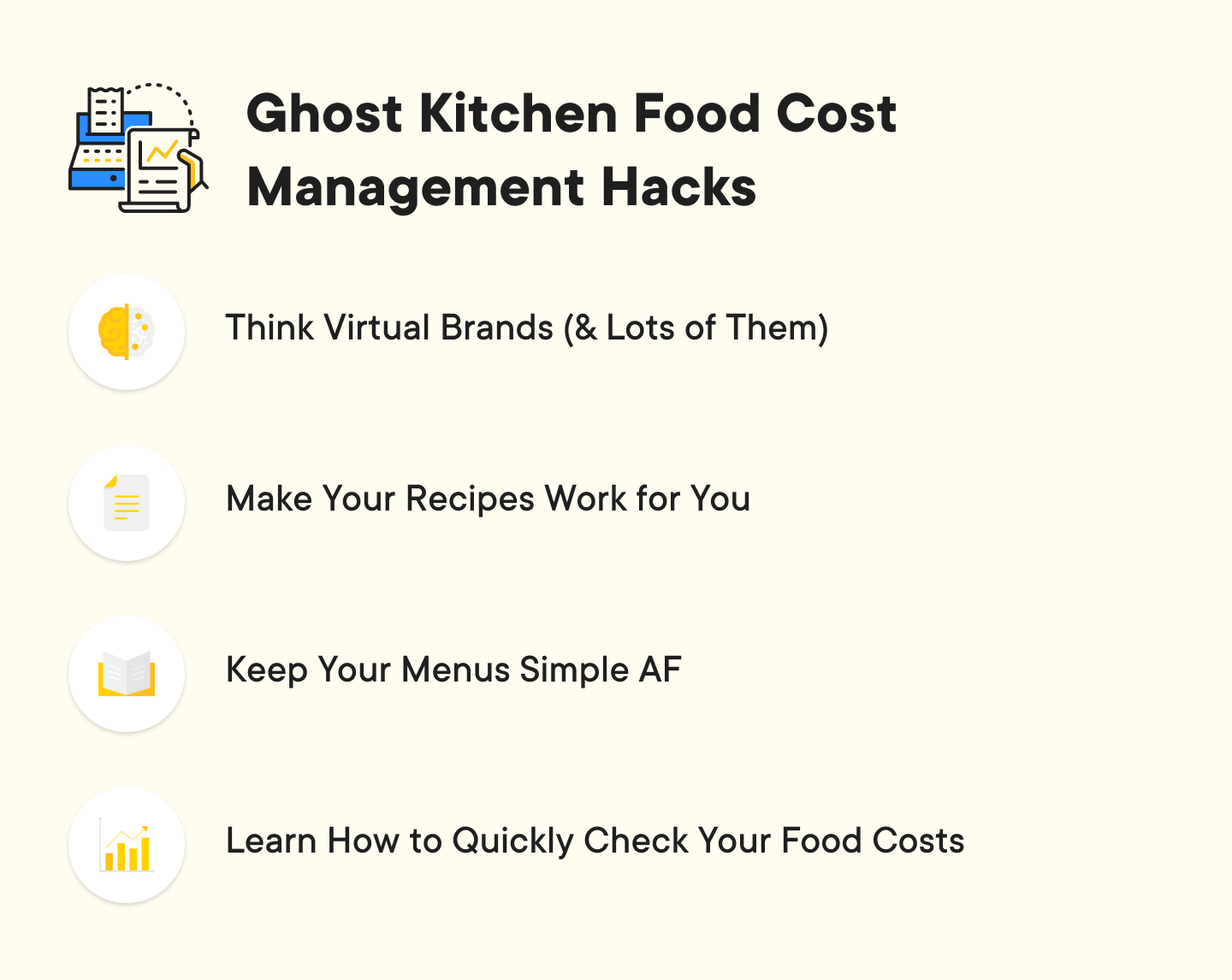
7. Denken Sie an virtuelle Marken (und viele von ihnen)
Das Schöne am Konzept der Cloud-Küche ist, dass man sich nicht auf ein einziges Esserlebnis festlegen muss. Endlich haben Sie die Möglichkeit, Ihre virtuellen Restaurantmarken so eklektisch und fusionistisch zu gestalten, wie Sie es schon immer wollten!
Prüfen Sie, was in den Bereichen, die Sie bedienen wollen, fehlt, und verschaffen Sie sich einen Vorsprung. Es gibt mehrere Sushi-Lokale in der Umgebung, aber keinen libanesischen? Und kein Ägypter?
Recherchieren Sie vor Ort, um herauszufinden, was es Ihnen wert ist, einen Hauch des Nahen Ostens in Ihr Viertel zu bringen. Ein guter Koch kann problemlos Gerichte aus ähnlichen Cousinen zubereiten (was zu geringeren Arbeitskosten führt).
Und aufgrund größerer Mengen der gleichen Rohstoffe können Sie mit Ihren Lieferanten bessere Konditionen aushandeln.
8. Lassen Sie Ihre Rezepte für Sie arbeiten
Da Sie Ihren Kunden ähnliche, aber unterschiedliche Stile anbieten, haben Sie für Abwechslung gesorgt. Bei den einzelnen Rezepten zahlt es sich jedoch aus, clever zu sein. Konzentrieren Sie sich auf die Gerichte, die die gleichen Hauptzutaten verwenden.
Wenn sich viele Zutaten zwischen den Menüpunkten überschneiden, können Sie sich (zu geringeren Kosten) eindecken. Noch wichtiger ist jedoch, dass Sie die Lebensmittelverschwendung auf ein Minimum reduzieren können, da Ihr Warenumschlag höher ist als der von Gaststätten.
9. Halten Sie Ihre Menüs einfach AF
Um eine kostengünstige Cloud-Küche zu betreiben, müssen Sie sich auf zwei Dinge konzentrieren: Geschwindigkeit und Volumen. Verabschieden Sie sich von der Vorstellung, dass Sie ein Feinschmeckerlokal betreiben, und legen Sie die Axt an Ihr überdimensioniertes Angebot.
Ihre Speisekarten müssen gestrafft werden, denn ein Überangebot an Auswahlmöglichkeiten löst das Netflix-Syndrom aus. Dies ist eine Überforderung, die dazu führt, dass die Kunden ihr Essen woanders bestellen.
Eine schlanke Speisekarte – mit höchstens 10 Artikeln – ist einfacher zu verwalten, billiger im Angebot und verursacht weniger Kopfzerbrechen (und Abfall). Oh, und 86 die meisten Ihrer französisch klingenden Gerichte (oder benennen Sie sie zumindest um) – die Haute Cuisine ist kein beliebter Lieferartikel und kann Sie in ein Loch fallen lassen.
10. Lernen Sie, wie Sie Ihre Lebensmittelkosten schnell überprüfen können
Wäre es nicht toll, wenn Sie Ihre Lebensmittelkosten einmal berechnen und dann einfach sagen könnten: „Wir sind bei 20 % und wir bleiben dabei?“
Das passiert einfach nicht.
Die Lebensmittelkosten steigen. Die Lebensmittelkosten sinken. Wenn Sie nicht wissen, wie Sie sie auf einen Blick erkennen können, können Sie darauf wetten, dass sie in der Regel nach oben gerichtet sind. Vermeiden Sie dies mit nützlichen Berechnungen: Umsatztage im Lager und Lagerumschlagshäufigkeit.
Oder lassen Sie sich von Apicbase über die Lebensmittelkosten informieren (und darüber, wie Sie sie niedrig halten können).
Ja, ich möchte die Lebensmittelkosten in meiner Cloud-Küche senken
Nutzen Sie Apicbase, um täglich datengestützte Einblicke zu erhalten, Ihren virtuellen Küchenbetrieb zu skalieren und Ihre Konkurrenz in den Schatten zu stellen.
Hacking von Immobilien- und Mietkosten für virtuelle Küchen
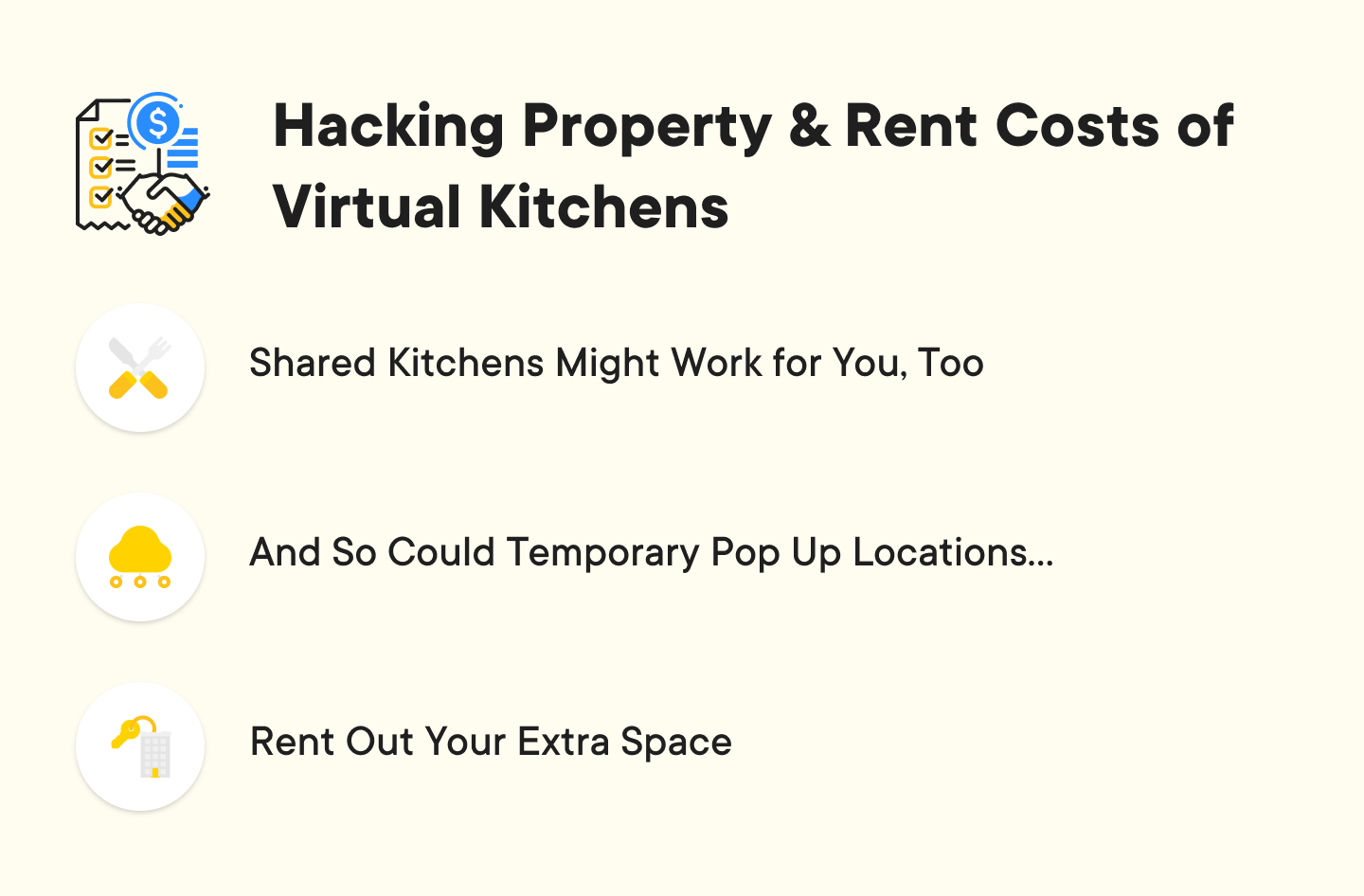
11. Gemeinsame Küchen könnten auch für Sie funktionieren
Vielleicht, vor allem, wenn Sie sich in einem großen Ballungsgebiet befinden, wo sie wie Pilze nach einem guten Regen auftauchen – ich habe diesen im Zentrum Londons nach 10 Sekunden googeln gefunden.
Gemeinschaftsküchen sind in der Regel voll ausgestattet, lizenziert und einsatzbereit. Sie müssen nur den Vertrag unterschreiben, Ihre Wolke und Ihre Zutaten mitbringen und sich an die Arbeit machen.
Allerdings müssen Sie für diese extrem niedrigen Anschaffungskosten auch Flexibilität in Kauf nehmen, was ebenfalls berücksichtigt werden muss. Gemeinschaftsküchen eignen sich hervorragend für virtuelle Marken vom Typ Mom&Pop, die einen Wiedererkennungswert haben, nicht rund um die Uhr arbeiten und sehr schlanke Menüs anbieten, die immer nachgefragt werden.
12. Und das gilt auch für temporäre Pop-up-Standorte…
… vor allem, wenn Sie ein Auge auf große Manifestationen und Ereignisse haben, die sich in Ihrer Nähe abspielen. Wenn Sie sich in der Nähe von Menschenansammlungen aufhalten, und sei es auch nur für ein paar Tage, können Sie große Mengen verkaufen, schnelles Geld verdienen und den Bekanntheitsgrad Ihrer Marke in einem bisher nicht bedienten Gebiet steigern.
Bei diesen Pop-up-Lokalen kann es sich um einfache Container handeln, die einen physischen Zugang ermöglichen (Liefer-Apps bedienen nur einen Umkreis von 2,5 km um Ihren Standort), aber auch um einen Ort, an dem Sie einem Gericht den letzten Schliff geben können. Bei dieser Art von Küchen wird der größte Teil der Vorbereitungen ohnehin an einem zentralen Ort durchgeführt.
13. Vermieten Sie Ihren zusätzlichen Platz
Wenn Sie viel Platz in Ihrer Küche haben, den Sie nicht nutzen, warum sollten Sie nicht andere virtuelle Marken in Ihrem Raum willkommen heißen und zu einer Gastgeberküche werden?
Je nach Größe Ihres Unternehmens kann dies schnell lukrativ werden. Im schlimmsten Fall gleichen Sie einen Teil Ihrer Darlehens- oder Betriebskosten für einen Monat aus, und wenn es nicht klappt, trennen Sie sich von dem Mieter.
Abfallmanagement für dunkle Küchen leicht gemacht
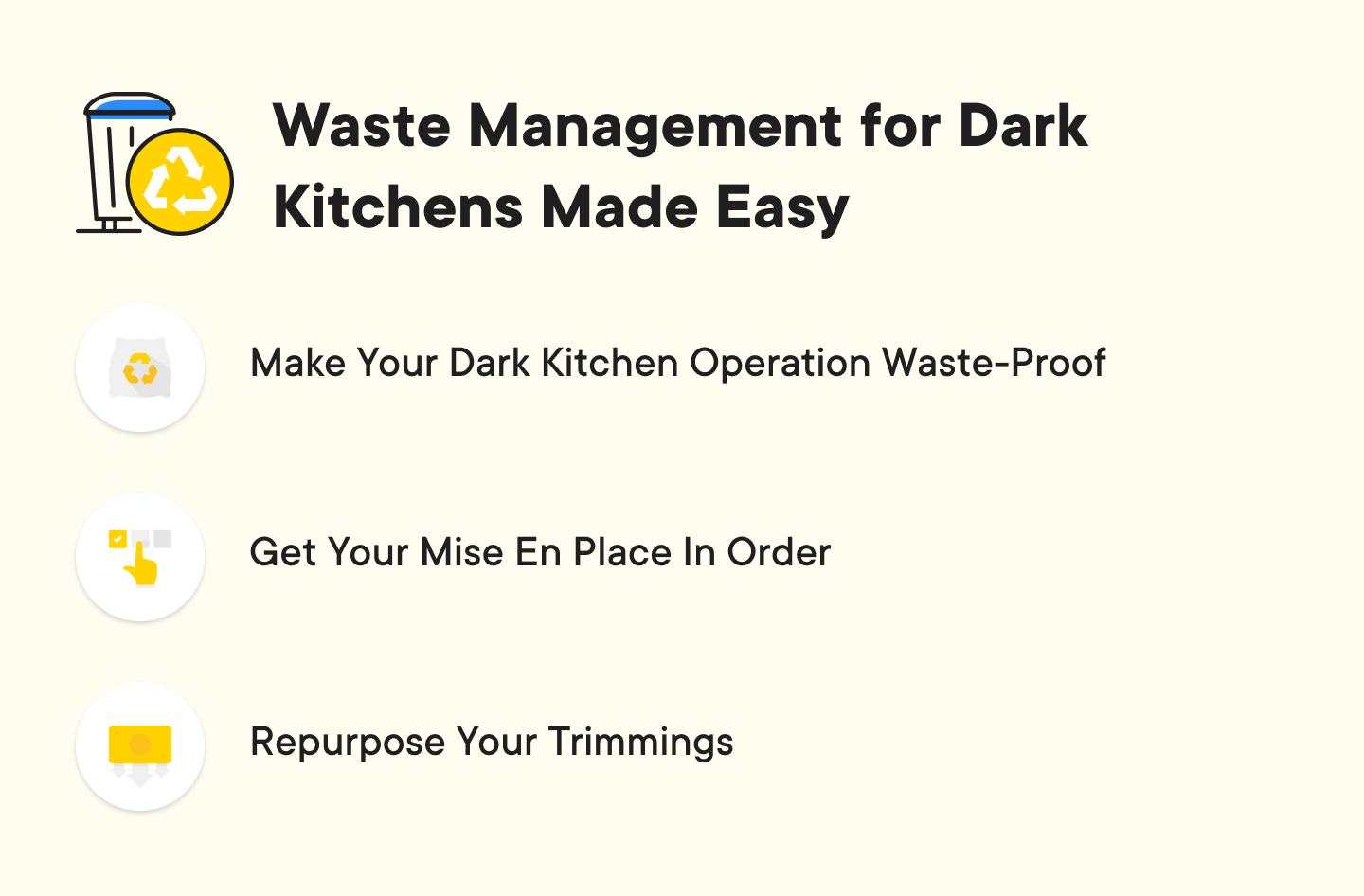
14. Machen Sie Ihren dunklen Küchenbetrieb abfallsicher
Die Bewirtschaftung von Lebensmittelabfällen hängt davon ab, dass die Mitarbeiter verstehen, was die Kosten der Verschwendung für das Unternehmen bedeuten. Und die Betreiber ringen oft damit, wie sie das angehen sollen.
Nun, das liegt an der Schulung, an detaillierten Arbeitsanweisungen und an diesem praktischen kleinen Trick, den ich Ihnen gleich verraten werde.
Lassen Sie die Mitarbeiter eine Woche lang alle Abfälle (bis hin zur letzten übergroßen Kartoffelschale) erfassen und ihnen einen Geldwert zuweisen. Wiegen Sie alles ab, füllen Sie es in Müllsäcke und lagern Sie es im Kühlschrank.
Wenn Ihre Mitarbeiter sehen, dass fünf große Tüten mit Lebensmitteln weggeworfen werden (wo eigentlich nur eine oder zwei sein sollten), werden sie anders mit Abfällen und Überproduktion umgehen. Meistens tun sie das aber nicht aus reiner Herzensgüte – ein Teil der zusätzlichen Kosten, die sie verursacht haben, war für ihre Bonuszahlungen vorgesehen (das sollten Sie ihnen unbedingt mitteilen).
15. Bringen Sie Ihr Mise En Place in Ordnung
Das bedeutet, dass man bis auf die Ebene des „Viertel-Zentimeter-Durchmessers-eines-Löffels-Zuckers“ herunterbohren muss.
Der gewöhnliche Küchenarbeiter mag es, wenn man ihm das Rätselraten abnimmt. Ansonsten bekommt ein Salat zwei Tomaten, ein anderer drei. Am Ende der Woche ernten Sie 20 % mehr Tomaten, als Sie eigentlich sollten.
Gehen Sie beim Mise en Place detailliert vor – bereiten Sie technische Datenblätter, visuelle Rezepte und Schulungsvideos vor. Und digitalisieren Sie alles, damit Sie es für einen anderen Standort bereit haben. Sie sparen Geld, Zeit… und wahrscheinlich auch ein paar Tomaten.
16. Wiederverwendung von Garnituren
Hier zahlt sich die Zeit und Mühe aus, die Sie in die Entwicklung von Rezepten investiert haben.
In einem Cloud-Betrieb ist es viel einfacher, Zutatenreste wiederzuverwenden als in einem gewöhnlichen Dine-in-Restaurant. Wenn Sie mehrere virtuelle Marken betreiben, könnte eine von ihnen trimmings-intensiv sein und Brühen, Suppen, Eintöpfe und ähnliches anbieten. Das gibt Ihnen die Möglichkeit, kreativ zu werden, ohne viel Material zu verschwenden.
Arbeitskosten-Hacks für Cloud-Küchen
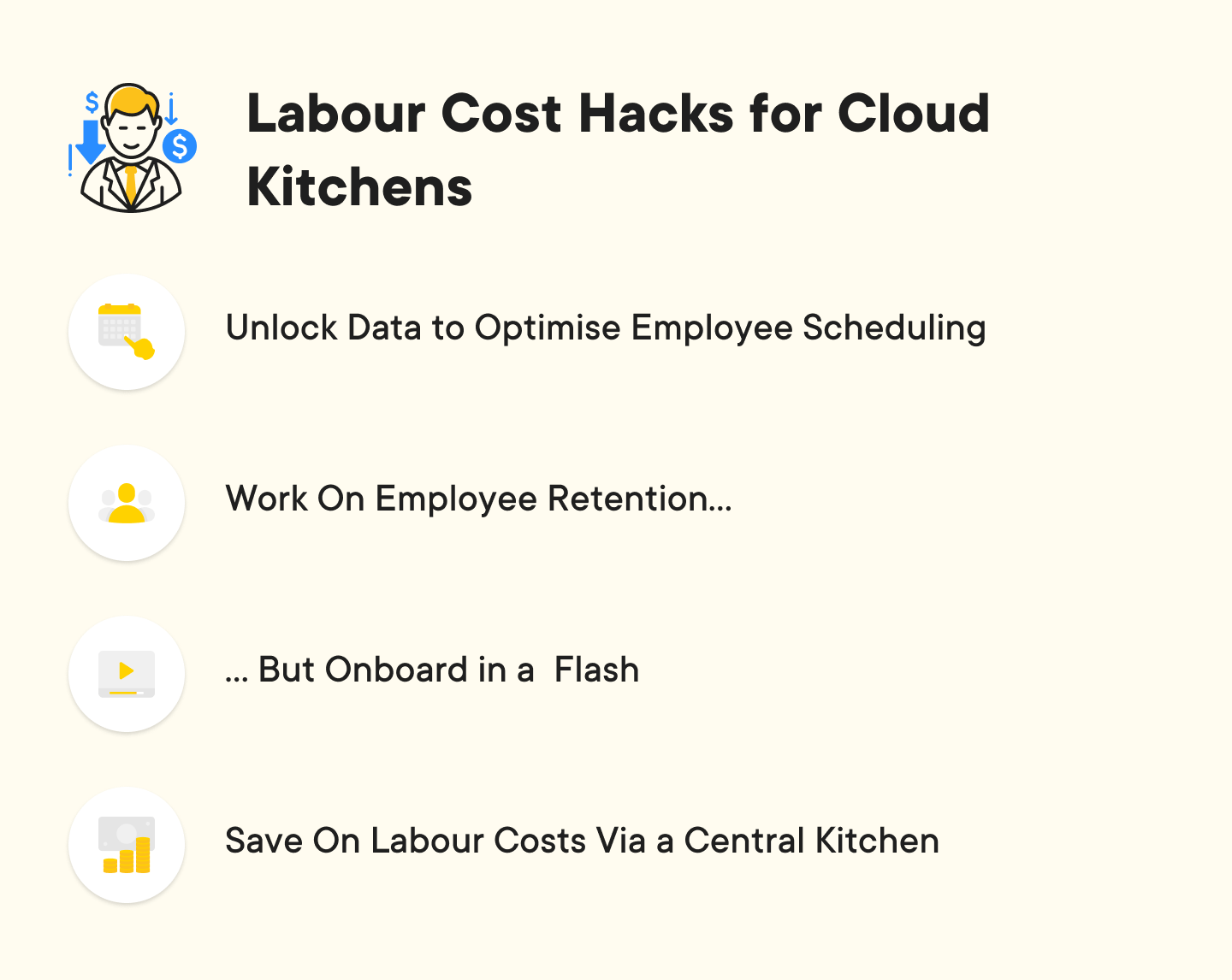
17. Daten zur Optimierung der Personaleinsatzplanung freischalten
Okay, Sie arbeiten also mit einer Minimalbesatzung. Bedeutet das, dass Sie nicht noch tiefer in die Materie eindringen können, um die Personaleinsatzplanung vollständig zu optimieren?
Nein, natürlich nicht.
Nach einer gewissen Zeit – und nach Konsultation Ihrer historischen Umsatzdaten – können Sie sicherstellen, dass in Ihrer Küche nie ein Paar Hände untätig ist. Manchmal (z. B. in den Nachmittagsstunden, wenn Ihre Sandwich-Marke die meisten Bestellungen erhält), brauchen Sie nur eine Küchenhilfe, um den Speck zwischen die Brotscheiben zu legen.
An manchen Abenden brauchen Sie vielleicht nur Ihren Chefkoch und einen Assistenten statt zwei (in der Mitte der Woche, wenn wenig los ist).
Nutzen Sie Ihre Daten, um zu wissen, wie viele Personen Sie wann benötigen. Im Zweifelsfall sollten Sie weniger Personal einstellen, aber jemanden in Bereitschaft halten, der einspringen kann, wenn es zu viel wird.
Ja, ich möchte meine dunkle Küche in eine datengesteuerte PU verwandeln
Nutzen Sie Daten zur Verbesserung der Produktion.
18. Arbeit an der Mitarbeiterbindung…
Auch das ist leichter gesagt als getan, denn die Fluktuationsrate in der Branche ist notorisch hoch.
Aber es gibt immer noch Möglichkeiten, erfahrene Mitarbeiter zu halten:
- wenn möglich leicht über dem Marktpreis zu zahlen;
- ein arbeitnehmerorientiertes Sozialleistungssystem ausarbeiten (z. B. subventionierte Kinderbetreuung);
- Schulungen und Mentoring (und Aufstiegsmöglichkeiten) anbieten;
- Engagement-Kampagnen und Belohnungen einführen.
Dies sind nur Ideen aus dem Stegreif (aber sie funktionieren in verschiedenen Branchen) – der Punkt ist, dass selbst bei dieser Art von Investitionen der Aufbau langfristiger Strukturen oft weniger kostspielig ist als die Einstellung/Schulung neuer Mitarbeiter alle paar Monate.
19. … aber blitzschnell an Bord
Manchmal ist es einfach nicht möglich, einen Mitarbeiter zu behalten. Sie müssen also zum x-ten Mal die ganze Einstellungsprozedur durchlaufen.
Beschleunigen Sie die Dinge, indem Sie das Onboarding blitzschnell gestalten. Versenden Sie Ihre Schulungsverfahren, SOPs und technischen Datenblätter an neue Mitarbeiter unmittelbar nach ihrer Einstellung (vor ihrer ersten Schicht). Ermutigen Sie sie, Prozesse und Arbeitsweisen kennen zu lernen.
Ihr bester Freund ist hier jedoch das Video. So nutzen Sie es aus:
- Schritt-für-Schritt-Stop-Motion-Videos für die Zubereitung von Speisen und das Anrichten erstellen;
- Video auf Ihre F&B-Management-Plattform hochladen;
- alles an einen Overhead-Küchenbildschirm anschließen.
Jetzt haben neue Mitarbeiter eine Anleitung auf Abruf und können während der Arbeit lernen. Sie lernen viel schneller, und der zusätzliche Bonus ist, dass das vorhandene Personal sie anleitet und berät (und nicht eine Woche lang die neuen Mitarbeiter an die Hand nimmt und wertvolle Zeit vergeudet). (Stichwort: Bescheidenheit – man kann auch schön Stop-Motion-Videos mit Apicbase, und wir können Sie mit modernster Technik versorgen).
20. Sparen Sie Arbeitskosten durch eine zentrale Küche
Wenn Sie mehrere Cloud-Küchen (physische Standorte) betreiben, um ein größeres Gebiet abzudecken, sollten Sie in Erwägung ziehen, den Großteil der Produktionsarbeit (z. B. lagerfähige Unterrezepte wie Brühen, Soßen, Teige usw.) an einen zentralen Standort zu verlagern.Auf diese Weise beschäftigen Sie weniger Köche und Souschefs (mittlere bis hohe Gehälter) und mehr Köche und Küchenhilfen (niedrigere Gehaltsstufen). Diese zentrale Küche kann in einem Gebiet mit niedrigen Mieten liegen, und Ihre Pop-up-Standorte können kleiner sein (so dass Sie insgesamt weniger Miete zahlen). Denken Sie daran, eine interne Lösung zur Auftragsverfolgung einzuplanen, da Sie sonst keinen Überblick über die Leistung der einzelnen Küchen haben.
Ja, ich möchte interne Aufträge leicht verfolgen können
Die Verwaltung mehrerer Standorte und Pop-up-Küchen kann schnell zu einem logistischen Albtraum werden. Apicbase hilft Ihnen, den Überblick über alles zu behalten.
Senkung der Kosten für die Lieferung der virtuellen Küche
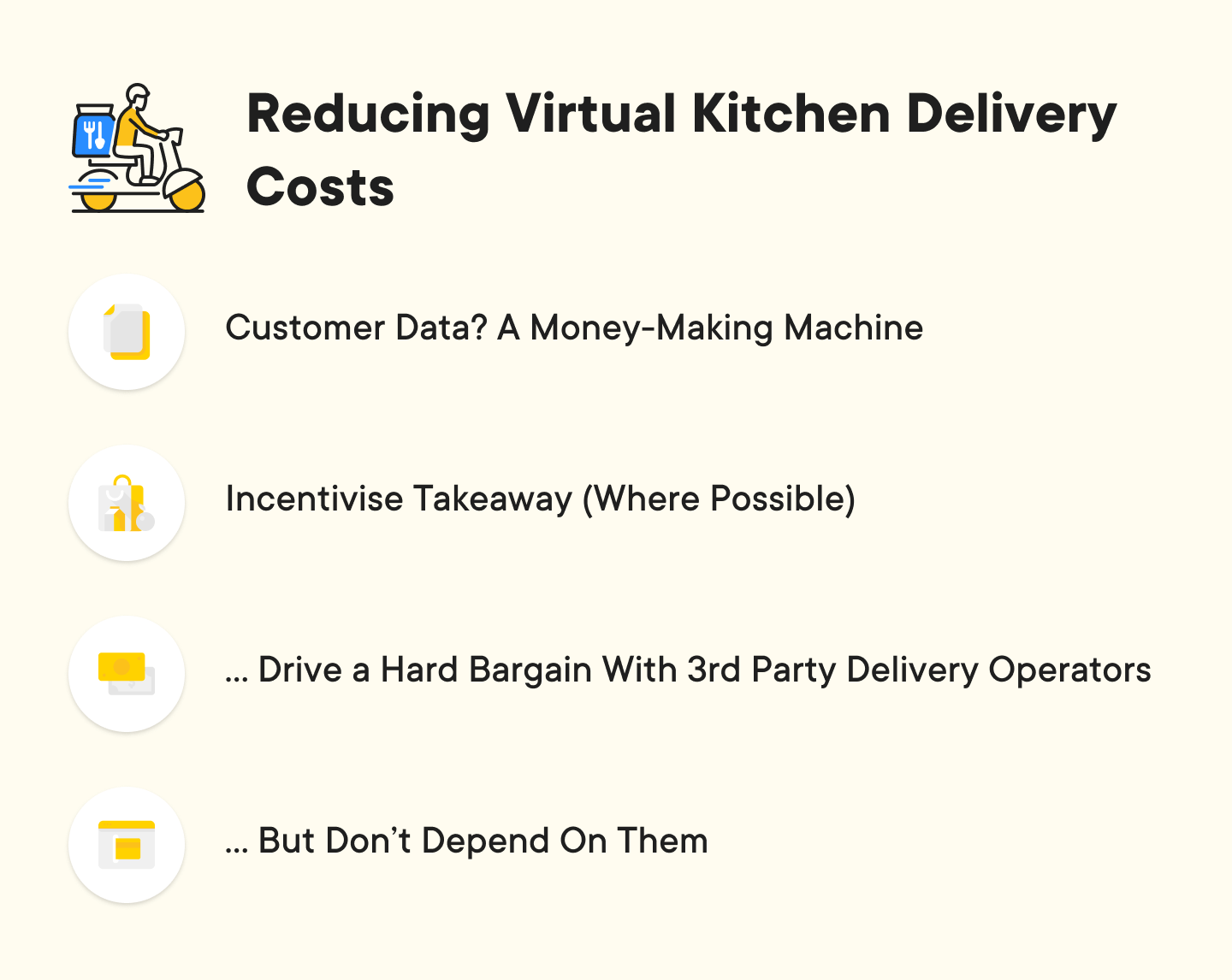
21. Kundendaten? Eine Geldgewinnungsmaschine
Zu leicht geben die Betreiber von Geisterküchen Kundendaten an Drittanbieter-Apps ab. Für einige, die nur eine einfache Küche betreiben wollen, ist dies sinnvoll. Wenn Sie jedoch Ihr Unternehmen vergrößern wollen, ist es ein absolutes Tabu, nicht zu wissen, wer Ihre Kunden sind (und wo sie sind).
Finden Sie eine Möglichkeit, gelegentlich Kundendaten zu erfassen – fügen Sie eine Vor-Ort-Bestellmöglichkeit hinzu, bieten Sie für einen kurzen Zeitraum einen Lieferservice zum Mitnehmen an, führen Sie einen Monat lang Ihren eigenen Lieferservice durch. Dies wird Ihnen dabei helfen, herauszufinden, wie und wo Sie skalieren oder was Sie bei einer Umstellung ändern sollten.
22. Anreize zum Mitnehmen schaffen (wo möglich)
Sie bereiten das Essen vor und der Kunde fährt zu Ihnen, um es abzuholen? Das ist die Bank, genau da. Es handelt sich um sauberes Geld mit geringen Gemeinkosten und ohne Lieferkosten.
Um Anreize zum Mitnehmen zu schaffen, sollten Sie eine Präsenz in den sozialen Medien, eine E-Mail-Liste oder Ähnliches aufbauen und daran arbeiten, Ihren Ruf zu verbessern (für eine oder alle virtuellen Marken). Sie können regelmäßig Gutscheine oder Rabatte nur für die Abholung anbieten und haben trotzdem niedrigere Gesamtkosten als bei jeder Art von Lieferung.
23. … Mit Drittanbietern ein hartes Schnäppchen machen
Ich will ehrlich sein: Der Spielraum lässt bei dieser Art von Verhandlungen sehr zu wünschen übrig. Die meisten Lieferdienste nehmen zwischen 20 und 30 % des Bestellwerts, bei Exklusivverträgen sogar nur etwa 25 %.
ABER – lassen Sie sich davon nicht abhalten, es zu versuchen.
Wenn Sie in Ihrer Küche etablierte Marken führen und ein Lieferdienstanbieter gerade erst in einen Markt eindringt, haben Sie die Chance, ihn unter 20 % des Auftragswerts zu drücken, zumindest für eine gewisse Zeit.
24. … aber verlass dich nicht auf sie
Der beste Rat, den ich je bekommen habe? Bauen Sie Ihr Haus nicht auf gemietetem Land.
Ich gebe es also weiter: Verlassen Sie sich nicht ausschließlich auf Lieferanwendungen von Drittanbietern. Ja, ich weiß – ich weiß, dass sie weitgehend für den Start des Konzepts der Cloud-Küche verantwortlich sind. Ja, sie helfen Ihnen, Geld zu verdienen.
Aber wir haben keine Ahnung, was die Zukunft bringt. Treffen Sie Vorkehrungen, damit Sie schnell umschwenken können, wenn es in der Branche unerwartete Wendungen gibt.
Wenn Sie bereit sind, können Sie Ihre eigene App, Website oder E-Mail-Liste erstellen. Fangen Sie langsam an, aber versuchen Sie, diesen Aspekt Ihres Unternehmens auszubauen. Die Zukunft der Cloud-Küchen könnte ein hybrides Modell sein, auf das Sie vorbereitet sein werden. Ein Mitnahmeschalter (oder eine Teillieferung, die nur an Wochentagen stattfindet) kostet nicht viel, aber es wird Ihnen helfen, das Wasser zu testen.
Es geht wirklich nur um Kostenkontrolle, wissen Sie?
Wie… wirklich wirklich.
Ich kann gar nicht genug betonen, wie wichtig es ist, die Kosten im Griff zu haben, wenn Sie mit Ihrer Geisterküche Gewinn machen wollen. Vor allem dann, wenn Sie Ihre Tätigkeit ausweiten wollen.
Jedes bisschen hilft hier – 0,5 % Einsparung bei den Lebensmittelkosten. 1 % aus Mülleimern gerettet. 2 % wurden durch die Feinabstimmung der Mitarbeiterschichten erreicht. Das alles summiert sich, und am Ende ist es das, was Ihr Endergebnis steigert.
Wenn Sie bereit sind, diese Kosten in den Griff zu bekommen und zu expandieren (denn wenn Sie expandieren, während Sie rote Zahlen schreiben, bluten Sie nur noch schneller aus), nehmen Sie Kontakt mit uns hier bei Apicbase auf.
Wir haben diese F&B-Verwaltungsplattform entwickelt und dabei ein Auge auf das Konzept der Cloud-Küche geworfen. Wir wissen, dass dies für Sie funktionieren wird.
Rufen Sie uns an. Und wir helfen Ihnen dabei, die lästigen Kosten zu senken.

Ja, ich möchte eine gewinnbringende Cloud-Küche betreiben
Tippen Sie auf die Schaltfläche unten und vereinbaren Sie noch heute einen 30-minütigen Gesprächstermin mit unseren Experten für Kostenkontrolle in der Gastronomie.

